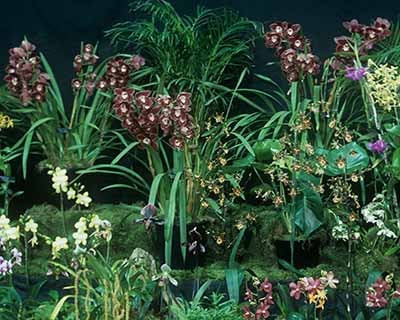Danger and Desire: The seductive power of orchids
A new exhibition at RHS Wisley (8th Feb – 1st May 2024) delves deep into the seductive allure of one of the largest plant families, found on nearly every environment on earth. See exquisite artworks and rare books from the RHS collections, which bring the exotic history of the orchid to life.
Orchids are extraordinarily diverse in their sizes, shapes and colours. Some are elegant, others are grotesque. Some seem to mimic insects, animals or even human body parts. But there is more to them than botanical variation. Throughout history, orchids have developed a powerful hold on our imagination.
Orchids and mystery
At first orchids bewildered botanists, particularly the tropical orchids which began to reach Western Europe in the 1700s. How did they grow? Were they parasites? How did they reproduce? Where were their seeds? What was the reason for their weird and varied forms?It took decades of careful study to unpack the mysteries of these plants which co-evolved with very specific habitats and pollinators. The elegant and complex mechanisms orchids evolved to manipulate pollinators made them a fascinating subject for scientists.
Orchids were also mysterious to gardeners. The struggle to keep them alive away from their
It was not until the 1960s that the mysteries of orchid
An expensive obsession
In the 1800s and early 1900s, orchids became a status symbol and expensive obsession for the wealthy. Rare orchids fetched astonishing prices and were cossetted in elaborate glasshouses. A small army of collectors, dealers, artists and authors grew up to serve this rich market.Gradually growers learnt to
Orchids and danger
Tropical orchids were associated with Western European ideas of the wild and dangerous jungle. This reputation was fostered by self-serving collectors and orchid dealers who wanted to exaggerate the risks they ran to push up prices.The science of orchid reproduction meant orchids unfairly gained a reputation for deceitfulness and cunning. In fiction they also became mixed up with carnivorous plants – to produce vampire orchid stories. But in fact orchids are in danger from humans rather than the other way around. The loss of habitat and pollinators that orchids depend on mean that many are in danger of extinction.
Highly perfumed, exotic looking orchids became connected with dangerous femmes fatale in popular literature. The fact that orchids were an expensive flower and looked artificial and stylised meant they were used as short-hand for louche, sophisticated and often immoral characters in literature and film.
9 fun facts about orchids
- Orchids are the largest plant family in the world – around 28,000 wild species have been discovered and over 100,000 more man-made
hybrid - Orchids are ancient – they have been around since the days of the dinosaurs
- Orchid flavoured ice cream? – The vanilla plant is an orchid, but in Turkey you can also buy orchid ice cream made from salep, a flour milled from dried tubers of wild orchids.
- Orchid seeds are so tiny they do not contain enough energy to germinate. – They rely on taking energy from funghi, without access to this external energy source they cannot germinate and grow.
- Orchids are used across the world – to make food, clothing, pigments, medicines, adhesives and even musical instruments.
- Their perfume is not always pleasant - In Japan special competitions are held where orchids are judged purely on the quality of their fragrance. But not all orchids are beautifully fragranced. The orchid Bulbophyllum beccarii has been described as smelling like ‘a thousand dead elephants.’
- The Bond villain Hugo Drax featured in Moonraker was an orchid collector who planned to use a poison derived from an orchid to poison the entire population of the earth so he could repopulate the planet with his own chosen ‘master race’.
- Orchids grow on every continent except Antarctica
- The Asian giant tiger orchid can weigh over a ton, with leafy canes over 8 feet long that produce 18-foot flowering stems
You can see Danger and Desire, The seductive power of orchids
8th Feb – 1st May 2024 at Wisley Gallery, Wisley Old Laboratory. The event is free with normal garden admission charges. No booking is required.
Find out more
More orchid history from our digital collection....
- Orchids on RHS Digital Collections
- Online exhibition - Enduring Beauty: Orchid portraits at the RHS
- Orchid nursery catalogues



